Unusual life cycle and impact on microfibril assembly of ADAMTS17, a secreted metalloprotease mutated in genetic eye disease
- PMID: 28176809
- PMCID: PMC5296908
- DOI: 10.1038/srep41871
Unusual life cycle and impact on microfibril assembly of ADAMTS17, a secreted metalloprotease mutated in genetic eye disease
Abstract
Secreted metalloproteases have diverse roles in the formation, remodeling, and the destruction of extracellular matrix. Recessive mutations in the secreted metalloprotease ADAMTS17 cause ectopia lentis and short stature in humans with Weill-Marchesani-like syndrome and primary open angle glaucoma and ectopia lentis in dogs. Little is known about this protease or its connection to fibrillin microfibrils, whose major component, fibrillin-1, is genetically associated with ectopia lentis and alterations in height. Fibrillin microfibrils form the ocular zonule and are present in the drainage apparatus of the eye. We show that recombinant ADAMTS17 has unique characteristics and an unusual life cycle. It undergoes rapid autocatalytic processing in trans after its secretion from cells. Secretion of ADAMTS17 requires O-fucosylation and its autocatalytic activity does not depend on propeptide processing by furin. ADAMTS17 binds recombinant fibrillin-2 but not fibrillin-1 and does not cleave either. It colocalizes to fibrillin-1 containing microfibrils in cultured fibroblasts and suppresses fibrillin-2 (FBN2) incorporation in microfibrils, in part by transcriptional downregulation of Fbn2 mRNA expression. RNA in situ hybridization detected Adamts17 expression in specific structures in the eye, skeleton and other organs, where it may regulate the fibrillin isoform composition of microfibrils.
Conflict of interest statement
The authors declare no competing financial interests.
Figures
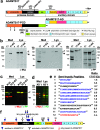
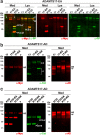
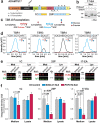

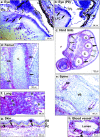
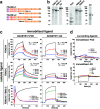
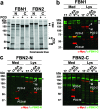


Similar articles
-
Adamts10 inactivation in mice leads to persistence of ocular microfibrils subsequent to reduced fibrillin-2 cleavage.Matrix Biol. 2019 Apr;77:117-128. doi: 10.1016/j.matbio.2018.09.004. Epub 2018 Sep 7. Matrix Biol. 2019. PMID: 30201140 Free PMC article.
-
Adamts17 is involved in skeletogenesis through modulation of BMP-Smad1/5/8 pathway.Cell Mol Life Sci. 2019 Dec;76(23):4795-4809. doi: 10.1007/s00018-019-03188-0. Epub 2019 Jun 14. Cell Mol Life Sci. 2019. PMID: 31201465 Free PMC article.
-
A novel ADAMTS17 variant that causes Weill-Marchesani syndrome 4 alters fibrillin-1 and collagen type I deposition in the extracellular matrix.Matrix Biol. 2020 Jun;88:1-18. doi: 10.1016/j.matbio.2019.11.001. Epub 2019 Nov 11. Matrix Biol. 2020. PMID: 31726086
-
ADAMTS proteins as modulators of microfibril formation and function.Matrix Biol. 2015 Sep;47:34-43. doi: 10.1016/j.matbio.2015.05.004. Epub 2015 May 7. Matrix Biol. 2015. PMID: 25957949 Free PMC article. Review.
-
The ADAMTS/Fibrillin Connection: Insights into the Biological Functions of ADAMTS10 and ADAMTS17 and Their Respective Sister Proteases.Biomolecules. 2020 Apr 12;10(4):596. doi: 10.3390/biom10040596. Biomolecules. 2020. PMID: 32290605 Free PMC article. Review.
Cited by
-
Hydrocephalus in mouse B3glct mutants is likely caused by defects in multiple B3GLCT substrates in ependymal cells and subcommissural organ.Glycobiology. 2021 Sep 9;31(8):988-1004. doi: 10.1093/glycob/cwab033. Glycobiology. 2021. PMID: 33909046 Free PMC article.
-
Proteolysis of fibrillin-2 microfibrils is essential for normal skeletal development.Elife. 2022 May 3;11:e71142. doi: 10.7554/eLife.71142. Elife. 2022. PMID: 35503090 Free PMC article.
-
Weill-Marchesani syndrome 4 caused by compound heterozygosity of a maternal submicroscopic deletion and a paternal nonsense variant in the ADAMTS17 gene: A case report.Am J Ophthalmol Case Rep. 2022 Apr 14;26:101541. doi: 10.1016/j.ajoc.2022.101541. eCollection 2022 Jun. Am J Ophthalmol Case Rep. 2022. PMID: 35496767 Free PMC article.
-
A common variant rs2054564 in ADAMST17 is associated with susceptibility to lumbar spondylosis.Sci Rep. 2023 Mar 25;13(1):4900. doi: 10.1038/s41598-023-32155-w. Sci Rep. 2023. PMID: 36966180 Free PMC article.
-
O-fucosylation of thrombospondin type I repeats is dispensable for trafficking thrombospondin 1 to platelet secretory granules.Glycobiology. 2023 May 17;33(4):301-310. doi: 10.1093/glycob/cwad006. Glycobiology. 2023. PMID: 36721988 Free PMC article.
References
-
- Bekhouche M. & Colige A. The procollagen N-proteinases ADAMTS2, 3 and 14 in pathophysiology. Matrix Biol. 44–46, 46–53 (2015). - PubMed
-
- Fujikawa K., Suzuki H., McMullen B. & Chung D. Purification of human von Willebrand factor-cleaving protease and its identification as a new member of the metalloproteinase family. Blood 98, 1662–1666. (2001). - PubMed
-
- Stanton H. et al.. ADAMTS5 is the major aggrecanase in mouse cartilage in vivo and in vitro. Nature 434, 648–652 (2005). - PubMed
Publication types
MeSH terms
Substances
Grants and funding
LinkOut - more resources
Full Text Sources
Other Literature Sources

